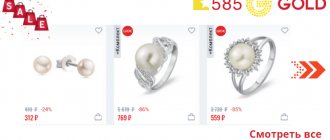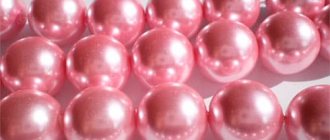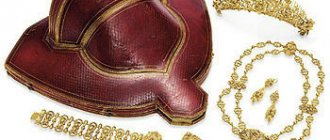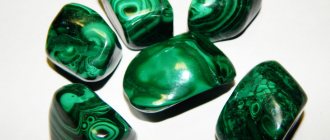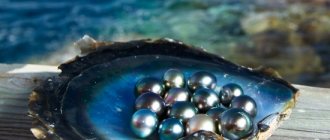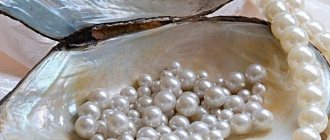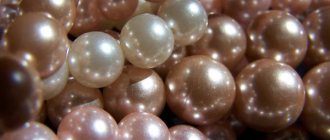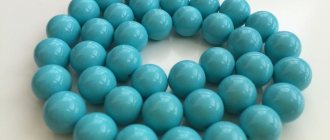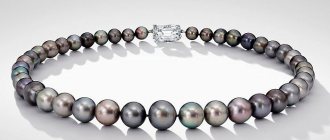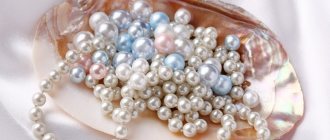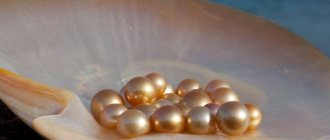Creator of a sparkling industry
The pearl farmers in the sparkling waters of Mie Prefecture owe much to the patience and perseverance of local native Mikimoto Kokichi (1858-1954).
Monument to the “Pearl King” Mikimoto Kokichi
Mikimoto Kokichi was the eldest son of the owner of an udon noodle restaurant in what is now the city of Toba, and became a seafood trader in the prefecture. Mie in the 1880s. He sold abalone (awabi) and dried sea cucumbers far from his homeland, in Tokyo. During one such business trip, he became interested in pearls, which were then even more expensive than now, since they were not grown artificially.
By that time, considerable efforts had already been made to produce pearls, especially in Europe, but these attempts were not crowned with success. Despite this, Mikimoto began farming Akoya pearl oysters in Ago Bay. After five years of trial and error, he managed to obtain hemispherical "bubble" mabe pearls that grew on the inner surface of the shell. His main success was just around the corner.
Hundreds of Akoya oysters suspended under rafts floating in Ago Bay
Two other pearl researchers working with Mikimoto at the same time were Mise Takuhei (1880-1924) and Nishikawa Tokichi (1874-1909), who filed competing patents on techniques for growing spherical pearls in 1907. Their agreement to work on developing pearl production made the "Mise-Nishikawa method" the industry's mainstay, but it was Mikimoto, who combined their achievements with the fruits of his efforts, who received a patent in 1916 for the production of round pearls in oyster mantles, opening the way to a commercially viable business for growing spherical pearls.
LiveInternetLiveInternet
Quote from message MARYASHA7
Read in full In your quotation book or community!
How the first ideally shaped pearl appeared: Kokichi Mikimoto and his great Japanese dream
“I will shower all the women of the world with pearls!” - he said, but he devoted all his work to only one, the one whom he lost so early. He went from a noodle merchant to a “pearl king”, was a scientist, a businessman, a jeweler, he curbed chance and made miracles controllable. Kokichi Mikimoto is the father of artificial pearls, which are not inferior, if not superior, to “natural” ones.
Contemporary necklace by Mikimoto.
Kokichi Mikimoto was born in 1858 into a poor family. He grew up on the coast and from childhood was fascinated by the mysteries of the origin of pearls. It was in those parts that pearl oysters were found, hiding pearls of incredible beauty in their bellies - but the huge scale of oyster harvesting brought this species to the brink of destruction. In his youth, the future “father of pearls” had to quit his studies to help his father, who sold noodles in the Avako tavern. And Kokichi himself had a dizzying career as a noodle or vegetable seller.
Contemporary necklace by Mikimoto.
Modern jewelry from the Mikimoto brand.
But Mikimoto was lucky with his marriage - at the age of seventeen he married a girl from a wealthy family. At first he did not think of giving up his usual life, he traded in a shop, but things were going badly. After consulting with his wife, he decided to start a new business. Her dowry allowed Mikimoto to purchase an oyster farm. And even then he began to think about how to make the process of creating pearls more efficient and controlled. Today cultured pearls seem to be something we take for granted, but in the second half of the 19th century it was believed that it was impossible to create perfectly round pearls in an “unnatural” way. Many scientists and farmers have struggled with this problem - to no avail. China has managed to grow artificial freshwater pearls, but they are not of high enough quality. The pearls turned out... whatever they wanted - just not perfectly round. But it was these pearls that were especially valuable!
Pearls grown using Kokichi Mikimoto technology.
Mikimoto faux pearl shades.
At the age of thirty, Mikimoto began his own experiments, choosing two convenient places - Shimmei Bay in Ago Bay and Ojima Island. In those years, at an oyster fair, he met a biologist who gave him some valuable advice on growing pearls. Kokichi used millions of sand grains of different shapes, sizes and compositions to trick finicky oysters into producing pearls of the correct shape. The oysters disagreed. Observations showed that they stubbornly reject foreign bodies. During a red tide (an amazing but dangerous natural phenomenon - a accumulation of algae), many of Mikimoto's oysters died... And he had to start from scratch.
Mikimoto pearl rings.
Mikimoto pearl rings.
But finally, in 1893, Kokichi Mikimoto's efforts bore fruit. He received artificial pearls of a semicircular shape. It took three whole years to obtain a patent - the fact is that Mikimoto was the first Japanese person to own a “biological invention.” The Mikimoto Pearl Farm generated stable income and created jobs in the region. But he did not intend to stop there. The pursuit of the perfect pearl continued, perfection remained elusive. In 1897, Kokichi's wife, who faithfully accompanied him on this difficult path, became seriously ill. The doctors were powerless to help her. At the bedside of the dying woman, Mikimoto vowed that in her memory he would create the most beautiful pearl in the world...
Modern jewelry from the Mikimoto brand.
Modern jewelry from the Mikimoto brand.
He had barely recovered from the loss of his beloved when a new tragedy befell him. In 1905, another red tide wiped out all of Kokichi's efforts. But he couldn't give up. From somewhere, invisibly, a woman was watching him, whom he dreamed of covering with pearls from head to toe - which means he had no right to give up his dream. And in 1908, one of the oysters presented him with a long-awaited gift - a luxurious pearl of a soft pink hue. The technology for growing it was incredibly complex, but now it could be repeated. Mikimoto's pearls were not inferior to the rarest pearls of natural origin for which India and Ceylon were famous, and to the same pearls that divers in his native Japan risked their lives to obtain. True, only five percent of the pearls were high-quality, which means it was necessary to expand production.
Today Mikimoto also uses the so-called baroque pearls - they are in trend.
Mikimoto's pearl farm transformed the region where he spent his childhood. Where he once ran barefoot along the coast, where he sold homemade noodles and rotting vegetables, something beautiful was now being created. Numerous buildings, workshops, sorting rooms and shops appeared on the island like mushrooms after rain. The infrastructure was changing, Mikimoto contributed to the emergence of new highways and railways, supervised the planting of gardens and the construction of new buildings. Restaurants and water shows have also opened there. The island has now received a new name - Tatokujima, Island of Great Benefit. Now red tides did not pose a threat to oysters - Mikimoto invented a special basket that protected the delicate sea creatures from the terrible algae. Today, the use of such baskets is widespread on oyster farms.
Reconstruction of a medieval Byzantine crown by Mikimoto craftsmen.
But resting on his laurels was not in the nature of Kokichi Mikimoto! Soon he began to think about finding a use for his pearls. He began to collect from them, as from a construction set, set decorations and trinkets - Buddha statues and temples, birds and butterflies. So Mikimoto from an oyster farm became a jewelry brand. And also the best-selling in the world! The brand's earrings with white pearls encrusted with diamonds are adored by Queen Elizabeth II of Great Britain. The technology of “embedding” a diamond into a pearl was also innovative.
Brooch with pearls. A copy of the biwa lute from the Shosoin imperial treasury.
Today Mikimoto is a real pearl empire, where science and art are tightly intertwined with each other, and the brand's boutiques are scattered throughout the world. Kokichi Mikimoto himself lived for almost a hundred years - and did not leave work until his last breath. In his homeland, a monument was erected to him - a bronze statue facing the sea. Since 1951, the Mikimoto Museum has been opened in the city of Toba, where both royalty and ordinary tourists love to visit. It houses masterpieces of jewelry art created by Mikimoto artisans, archival photographs, videos and the best pearls of the farm. Text: Sofya Egorova.
Source:
Modern pearl production
The method, first discovered by the “Pearl King” Mikimoto, is still used today, a century later. Although the growing process itself is almost the same as in his time, the latest technologies are used to protect the oysters.
The Shell-Lingual system consists of sensors attached to oysters and a floating unit that generates electricity and sends signals to shore
The Shell-Lingual alarm system was developed to alert farmers to deteriorating water conditions in which pearl oysters grow. Changes in the environment can affect the amount of oxygen in the water, which is important for oysters, or cause “red tides”, consisting of algae or toxic substances, which are dangerous for shellfish.
The system's sensors are attached to a certain number of oysters and allow farmers to know how open the shell valves are. The rapid opening or closing of the doors indicates that the animals are under stress, and farmers immediately receive a message on their mobile phone. This allows them to move the shellfish to another part of the bay in time or change the depth at which they are located.
Mikimoto Museum
Today, the island near Toba, where Mikimoto achieved success in obtaining spherical pearls, has been turned into his museum. In the early years of pearl production, outsiders were not allowed there, but since 1951 it has attracted millions of visitors, including queens, princes, heads of state and big business tycoons who are interested in these beautiful jewelry.
At the Mikimoto Pearl Island Museum you can see how these jewels are made
The first floor of the Mikimoto Pearl Island Museum shows how Mikimoto first cultivated pearls. There are about 100,000 varieties of oysters, but only six of them are suitable for pearl production. Farmers in Mie use mainly Akoya oysters, black-lipped oysters in Tahiti are prized for black pearls, and large white-lipped oysters produce large South Sea pearls.
Museum visitors are taught how pearls can be grown using methods developed by Mikimoto Kokichi
The museum shows that only 5% of oysters produce perfect pearls, and about 50% of the mollusks die. Irregular pearls are not thrown away; they are used in pharmaceuticals and cosmetics.
Strings of pearls of different shades
The museum also shows the selection of pearls for strings of pearls - their makers must have good eyesight to sort pearls by luster, color and size. Along the stairs you can also see many photographs related to the pearl business in different regions of the world, including images of the famous Ama divers in the prefecture. Mie.
Women demonstrate the traditional way of obtaining seafood by Ama divers at the Mikimoto Pearl Island, located in Toba Prefecture. Mie
On the upper tier of the museum, visitors can admire works of art in which pearls are used. The museum began building a jewelry collection in 1985, and it now includes about 250 pieces.
The exhibition features a gold brooch made in southern Germany around 1600. In it, two pearls are located next to jade. The Maltese cross from England, made around 1830, is decorated with pearls and emeralds.
The beautiful biwa lute is made of rosewood and quince and inlaid with gold, platinum, mother-of-pearl, 6284 akoya pearls and 4408 diamonds with a total weight of 220 carats.
Mikimoto craftsmen also created a number of major works of art, including a replica of the famous biwa lute from the Shosoin imperial treasury and a reconstruction of a medieval Byzantine crown with 796 premium pearls and 17 diamonds, which took 14 months to complete.
Crown made by Mikimoto craftsmen in 1979 and including 796 selected company pearls and 17 diamonds
Pearl Empire of Mikimoto
“My dream is to decorate the necks of all women in the world with pearls” - Kokichi Mikimoto.
Pearls are one of the most exquisite and most beloved women's jewelry for many centuries. He is always in fashion. A hundred years ago, only very wealthy people could afford to buy pearls. A string of good pearls (calibrated and tone-matched) could cost a fortune. For example, French jeweler Jacques Cartier bought a house on Fifth Avenue in New York in 1916 for two strings of good pearls. But today you can easily buy pearls of any quality and color at a very affordable price. It is only thanks to cultured pearls that we see such abundance. One of the founding fathers of the cultured pearl industry is the Japanese Kokichi Mikimoto. He did a great job of researching mollusks and pearls. It was he who developed the technology for commercial cultivation of cultured pearls. The process developed by Mikimoto is almost identical to what happens in nature - a person simply introduces a foreign body into the shell of a mollusk and protects its development by placing it in a safe environment. Mikimoto was also a great entrepreneur. He created the Mikimoto brand and managed to popularize Japanese pearls in the USA and Europe. Since the company's inception in 1893, women around the world have been in love with cultured pearls...the mysterious treasure of the sea. Kokichi Mikimoto won the title of pearl king during his lifetime, but his path to universal recognition was long and thorny.
Kokichi Mikimoto was born in 1858 in the Japanese town of Tobo. His father ran a small tavern that sold homemade noodles. The income was small, and the family did not live well. Mikimoto dropped out of school at the age of 13 and began working as a noodle boy. He never studied again. When Kokichi was 23 years old, he married a girl named Ume from a noble and wealthy family. Throughout her short life (Ume died when she was only 32 years old), his wife supported all of Kokichi’s endeavors and provided him with every possible assistance in his business. Together they bought their first oyster farm. While breeding oysters, Kokichi Mikimoto first thought about the possibility of growing genuine, high-quality pearls in such artificial conditions. The technology of pearl cultivation has long been known in China. But, truth be told, these were freshwater, river and low-quality pearls.
In 1878, Mikimoto helped organize a pearl exhibition in Japan. Everywhere he saw deformed and low-quality pearls. Kokichi Mikimoto was concerned about the greed of the pearl industry, which was only interested in profit and did not care at all about the quality of the pearls. In 1888, Mikimoto received a loan and founded his first pearl farm in Shinmei, at the entrance to Ago Bay, Mie Prefecture. Work on obtaining cultured pearls required enormous physical and material efforts, which Kokichi Mikimoto put into his favorite business, more than once finding himself almost on the verge of bankruptcy.
Among the thousands of species of mollusks existing in nature, only six are capable of producing pearls. One of them, namely the Akoya mollusk, was used by Mikimoto to cultivate pearls. Cultured pearls are obtained by injecting solid particles into the body of an oyster. The foreign particle, layer by layer, is enveloped in nacre, resulting in the formation of a pearl. Mikimoto sat day after day at the microscope, searching for the best options - size, location and material of the replant. I was looking for regimes for keeping shellfish in water. But the red tide in November 1892 caused the death of most of the oysters that Mikimoto grew in Shinmei Bay off the island of Bentenjima, and many experiments had to be started from scratch. However, the scientist’s careful work and patience still bore fruit, and in 1893 he extracted his first, semicircular pearl from an oyster. Kokichi Mikimoto dedicated his long-awaited success to his wife Ume, who helped him in his work. The patent for semicircular pearls was received on January 27, 1896. Due to the fact that there was no precedent for issuing patents for inventions relating to biological objects, the entire registration process took 15 months.
In 1899, Mikimoto opened the first pearl shop in Ginza, a fashionable district of Tokyo. There, wealthy citizens could buy natural pearls and hemispherical cultured pearls.
Mikimoto decided to expand his project, and a pearl farm was created on an uninhabited island in Ago Bay. The island was later named Tatokujima - "Island of Great Benefit". Kokichi Mikimoto continues to work hard to grow a perfectly round pearl. Conducting a very complex experiment - tiny balls of mother-of-pearl were placed into three-year-old oysters, and particles of the nacre gland of another, younger oyster were placed as an “additive”. In the spring of 1905, another red tide caused the death of 850,000 oysters. However, this time, when Mikimoto opened one of the oysters, he discovered a perfect spherical pearl! From that time on, a completely new period began for his company and the world jewelry industry - the period of cultured pearls. The exclusive patent expired in 1921, and since then the ingenious discoveries and technologies of Kokichi Mikimoto have been used all over the world.
Amazed by the modern design and manufacturing techniques of European jewelry, Kokichi Mikimoto opened his factory in 1907 to create the unique Mikimoto style, the first large-scale jewelry manufacturing enterprise in Japan. Mikimoto managed to create an international business by opening a store in London in 1913. Many other stores will be opened subsequently.
In 1924, the Mikimoto brand received the highest attention from the imperial family; several pieces of jewelry were ordered from Kokichi Mikimoto, including tiaras (some of them are now kept in a museum on Toba Island). For many years, Mikimoto remained a supplier to the Japanese Imperial Court, as it remains today. And in 1930, Kokichi Mikimoto, considered in imperial circles as one of the 10 greatest Japanese inventors, was invited to dinner at the Imperial Palace along with other inventors.
Mikimoto had to constantly fight the claim that his pearls were only “imitations” of real pearls. He took every opportunity to personally advertise his pearls. In 1926, Mikimoto participated in the Philadelphia World's Fair, where he unveiled a five-story pagoda elegantly modeled after the design of the Horyuji Temple and covered in Mikimoto's cultured pearls. It is now on display at the pearl museum on Mikimoto Pearl Island.
In 1927, during a trip to the United States, Mikimoto visited the inventor Thomas Edison. Having presented his pearl to the famous American, he heard words that sounded like the highest praise from the lips of a man who had learned from his own experience the value of many discoveries: “These are not cultured, but natural pearls. There are two things that cannot be obtained in my laboratory - diamond and pearl. Your invention of pearl culture is one of the wonders of the world!”
In 1933, at the World's Fair in Chicago, Mikimoto exhibited a model of George Washington's residence. Made from 24,328 pearls, this valuable creation was donated to the Smithsonian Institution in Washington, where it remains to this day.
New technology for growing pearls allowed the Japanese pearl industry to rapidly expand, but at that time there were few people willing to buy pearls. In 1935, there were 350 pearl farms in Japan, producing up to 10 million cultured pearls per year. The Japanese pearl industry is facing overproduction and falling prices for cultured pearls. Mikimoto, to prevent further price declines, publicly burned several tons of low-quality pearls. This promotion was a publicity stunt to create a reputation that Mikimoto only sold high quality cultured pearls.
In 1937, the Arrow Wheel clasp was introduced at the Paris Exhibition with interchangeable installations in 12 different shapes. Her design is a breakthrough in multifunctional jewelry. Depending on how you assemble the individual parts, you can create not only clasps, but several brooches, hairpins and even rings. Today she is located on Mikimoto Pearl Island.
In 1939, Mikimoto recreates the Liberty Bell in Philadelphia for the New York World's Fair. Decorated with 12,250 pearls and 366 diamonds, it earns the nickname “Million Dollar Bell.” It is now on display at the Mikimoto Pearl Museum.
After World War II, Mikimoto opened stores in Paris, New York, Chicago, Boston, Los Angeles, San Francisco, Shanghai and Bombay. He created one of the first Japanese brands to gain international recognition.
In 1954, Joe DiMaggio presents Marilyn Monroe with a 16-inch strand of Akoya cultured pearls during their honeymoon in Japan. At the time, single-strand white pearl necklaces were all the rage in both the US and Europe. It was one of the few “real” pieces of jewelry that the actress valued.
Kokichi Mikimoto died at the age of 96 in 1954. His achievements were highly appreciated - during his lifetime he was awarded the Order of Merit, and after his death he was awarded the highest award of the Land of the Rising Sun - the title "National Treasure". Later, in 1985, a bas-relief of Kokichi Mikimoto was placed in the Patent Office among the exhibits of the Ten Great Inventors of Japan series. And on Pearl Island (formerly called Ojima), a bronze statue of Mikimoto now stands proudly, facing the ocean. Pearl Island of Mikimoto became the center of the Mikimoto Empire. Production complexes and demonstration pavilions are located here; this place has become a “pearl Mecca”. The Mikimoto company continues the work of its founder even after his death.
The National Cherry Blossom Festival in Washington DC has been an annual event celebrating Japanese-American friendship since 1912 (the tradition was only interrupted during World War II). In 1956, Mikimoto creates a crown and donates it to the festival committee for the annual crowning of the Cherry Blossom Queen.
In 1969, Mikimoto wins the DeBeers Diamond International Award for his jewelry design with the Prelude to Space brooch.
In 2002, she created crowns for the Miss Universe, Miss USA and Miss Teen USA competitions. The intricate design of Mikimoto crowns, made from cultured white South Sea and Akoya pearls, embodies the ancient symbol of the phoenix, rising to symbolize status, power and the vision of great beauty.
Today, Mikimoto is the largest producer of the highest quality cultured pearls and one of the world leaders in the design of stunning jewelry. Every year collections are created with new amazing jewelry.
The Pearls in Motion collection features varied, playful and functional designs. The patented mechanism allows each pearl to be individually moved along the gold chain, creating endless options with one piece of jewelry.
Stormy Weather Collection - Mikimoto and fashion designer Yohji Yamamoto combine their talents to create an exceptional line of limited edition jewelry.
The joint project Mikimoto x Hello Kitty jewelry collection includes 20 accessories made of gold, silver, diamonds, rubies and, of course, pearls. Among them: a hair decoration, a tiara with medallions in the shape of strawberries, inside of which there is a portrait of a cartoon cat, as well as a necklace, earrings, rings and more.
There are few brands in the world that can compete with Mikimoto in making pearl jewelry. Mikimoto jewelry has been worn by all celebrities - from Marilyn Monroe to Grace Kelly. Both past and present, Mikimoto craftsmen have always adhered to the strictest quality standards. Out of a hundred pearls, only three to five are selected to create jewelry. The criterion for their selection is the perfection of surfaces, gloss, color and shape. The desire for absolute identity of pearls used in one necklace is a distinctive feature of Mikimoto jewelry. This often takes years. The color of a pearl depends on the color of the nacre inside the shell. There are five predominant primary colors: white, yellow, pink, pale green and blue. Less common are black pearls, grown mainly in the South Seas near Tahiti and the Tuamotu archipelago. Mikimoto craftsmen use black pearls to create the most ceremonial items. Mikimoto jewelers own the patent for “implanting” diamonds into the “pearl body”. The sparkle of diamonds highlights the natural beauty of pearls in the best possible way.
The current Mikimoto line includes jewelry of all classes, made of silver, gold of various colors and platinum. In almost every piece of jewelry, pearls are combined with precious stones - diamonds, emeralds, sapphires, rubies, aquamarines, beryls, jade and tanzanites.
